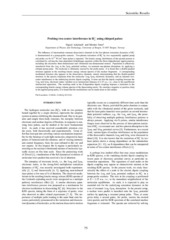Probing two-center interference in H2+ using chirped pulses
Peer reviewed, Journal article
Submitted version
Permanent lenke
https://hdl.handle.net/1956/7414Utgivelsesdato
2013Metadata
Vis full innførselSamlinger
Originalversjon
https://doi.org/10.1103/physreva.88.043411Sammendrag
The influence of intermediate resonant dissociative channels in the few-photon ionization dynamics of H+2 is demonstrated in a pump-probe scenario. Two-photon ionization of H+2 by two sequentially applied pump and probe vuv/fs 1011 W/cm2 laser pulses is reported. The kinetic energy distribution of the ejected protons is calculated by solving the time-dependent Schr¨odinger equation within the Born-Oppenheimer approximation, including the electronic three-dimensional and vibrational one-dimensional motion. Population is effectively transferred from the 1sσg to the 3pσu potential surface, via resonant one-photon absorption, by applying a chirped pump pulse. The molecule is ultimately ionized by the probe pulse. It is found that a double-peaked structure appears in the resulting kinetic energy release spectra of the nuclear fragments. A corresponding modulated structure also appears in the dissociative channels, merely demonstrating that the double-peaked structure in the spectra originates from the molecular 1sσg-3pσu electronic dynamics, and an inherent twocenter interference in the underlying electric dipole coupling. It turns out that the dipole coupling between the 1sσg and 3pσu electronic states vanishes at an internuclear distance of 2.25 a.u., i.e., close to the equilibrium internuclear separation. The resulting node in the R-dependent dipole coupling imposes a minimum in the corresponding kinetic energy release spectra of the dissociating nuclei. By creating a negative or positive chirp in the applied pump pulse, it is found that the modulations can be made more or less salient.
